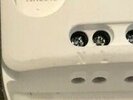Nest Heat link isn't really designed for systems that only have pumped central heating and gravity circulation of hot water. So it requires some lateral thinking. The boiler has to be 'on' when heating the hot water, and the pump and the boiler both have to be 'on' for the heating. The difficult part is to isolate them electrically so that the pump doesn't come on when the hot water only is required. Normally this isolation is provided by the microswitches in motorised valves, but as there aren't any present, it can be achieved by using the hot water switch in the Heat link to provide isolation.
EDIT:
Here's a description of how it works:
1. When hot water only is set 'on' (5) and (6) are connected together by the Nest. (6) is connected to the live, therefore (5) becomes live and the boiler operates and water circulates around the hot water cylinder by natural circulation. The radiators don't heat up because the pump is off.
2. When heating only is 'on' (2) and (3) are connected together by the Nest. (2) is connected to the live, so (3) also becomes live and the pump starts. As hot water is not required, (4) and (5) are connected together by the Nest, As (4) is connected to (3) by a link, when the heating comes 'on' (5) also becomes live via the heating section of the Nest and the pump and boiler operate. This is the 'fly in the ointment' bit, because as the boiler needs to run for the radiators, the hot water will also heat up. But this is because of the plumbing restrictions.
3. When heating and hot water are 'on' (5) and (6) are connected together by the Nest. (6) is connected to the live, (5) becomes live and so the boiler operates. Also (2) and (3) are connected together by the Nest and the pump runs also. Water is thus pumped around the radiators, and the hot water is heated by gravity circulation.


